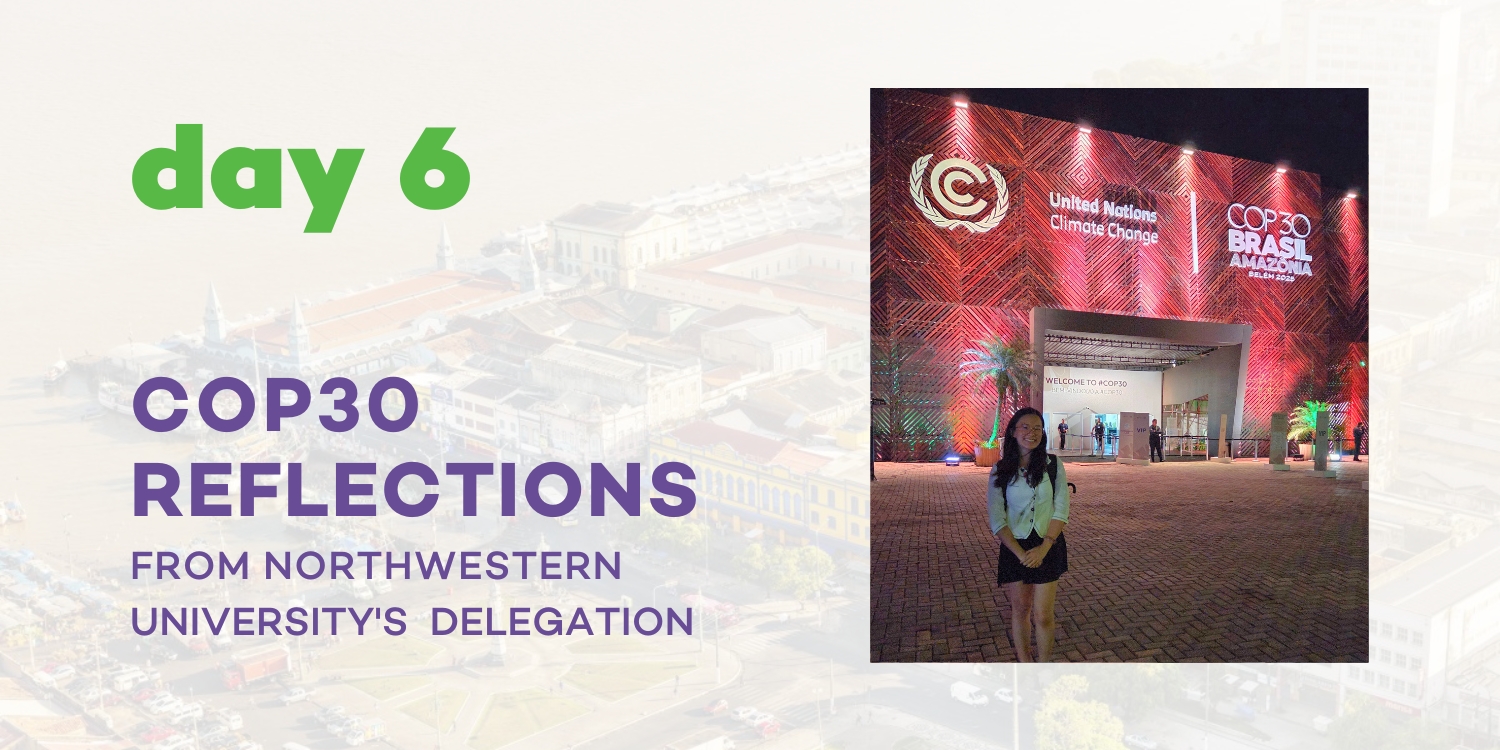Reflections from Northwestern University's COP30 Delegation: Day 6
For a fifth year, a delegation of Northwestern University students and faculty supported by the Roberta Buffett Institute is among more than 50,000 researchers, policymakers, industry leaders, and activists at the world’s largest annual international treaty negotiations and climate summit, the 30th Conference of Parties (COP30) to the United Nations Framework Convention on Climate Change (UNFCCC), held this year in Belém, Brazil. Each day, a different Northwestern delegate is blogging about their experiences and reflections. Day 6 features Minjung Kim, a PhD candidate in the Department of Chemistry.
A Week at COP30: What Belém Taught Me About Science Communication
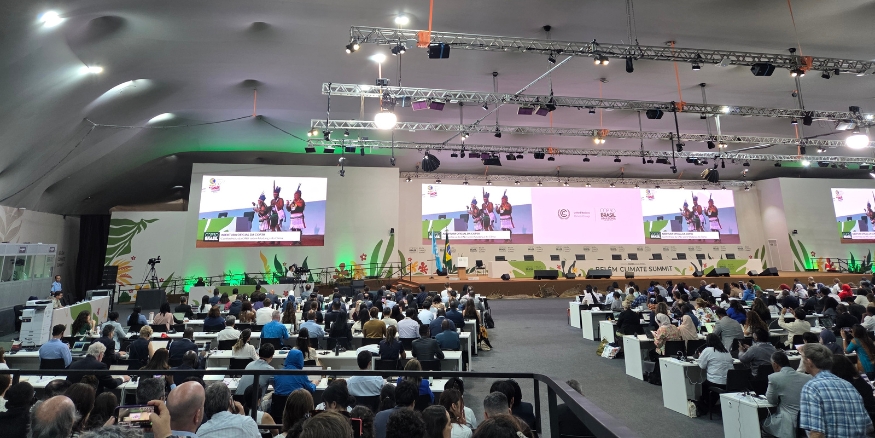
COP30 opening ceremony from the overflow room
A week ago, I arrived in Belém with excitement, curiosity, and uncertainty, as I have never attended a global conference or performed research outside of my field. I am now writing this post from the airport on the way back to the US, reflecting on how much I learned about global climate governance and the ways science, policy, and society intersect.

Left: Discussions of science diplomacy held at the Science for Climate Action Pavilion
Right: Greenpeace press conference
At COP30, I wanted to understand how the complex science behind climate change and tools for its mitigation are translated into implementation at the global negotiating table. For example, a topic I was interested in was carbon capture, utilization, and storage (CCUS) as it is highly relevant to my PhD. I would have explored how the science behind CCUS is explained, what research was cited in these proposals, what parties provided such data, and emotional framing (i.e., language used to suggest a sense of urgency, feasibility, etc.) around the discussion. During days I had badge access, I attended many different panels, events, and negotiations in the blue zone to understand how science is framed in these settings. However, after attending first few negotiations, I quickly realized that scientific details were not included in negotiations, but rather, it was more about how science was used by different parties, and their motivations (e.g., financial, political, mitigation vs. adaptation, etc.) behind using specific language.

Presentations and events in the blue zone
I was closely following the negotiations behind the Subsidiary Body for Scientific & Technological Advice (SBSTA) agenda item 4: Research & Systematic Observation (RSO). Essentially, the SBSTA reviews the best available climate science, monitors global observation systems (e.g., systems that monitor the atmosphere, oceans, greenhouse gases, etc.), identify gaps in knowledge and support needs in developing countries, and provide technical advice for adaptation, early warning systems, and loss and damage planning. The key debates were surrounding the type of data to include (single-year versus long-term trends), what constitutes “best available scientific knowledge,” how the Intergovernmental Panel on Climate Change (IPCC) is referenced, and the linking of financial support and capacity-building to RSO, particularly for developing countries and vulnerable regions.
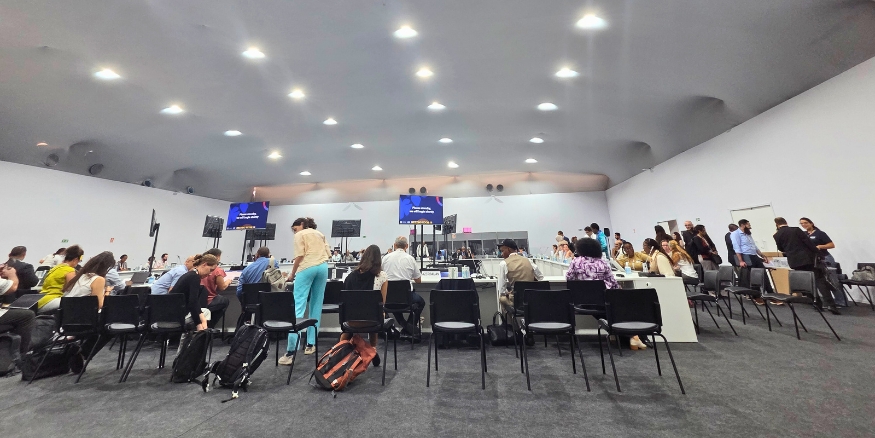
Typical negotiations setting (photo taken before the start of the meeting)
The floor was mainly split between developed countries (European Union (EU)) versus developing countries (India, Saudi Arabia, Kenya). When it came to the data that was to be included in the draft conclusions, developed countries strongly pushed for single, most recent data on the rate of emissions to highlight urgency of climate change. However, developing countries strongly pushed for cumulative emissions to highlight the overall trajectory of climate change.
Context is important here: historical emissions largely originate from developed countries, while current emissions are growing in developing countries as they industrialize. In my opinion, the debate between rate versus cumulativeemissions in the text reflects the broader tension in global climate politics between historical responsibility for emitters and the right to development for developing countries. This focus on accountability carries over to discussions on “best available scientific knowledge” and financial support, where much of the debate centered on whether the text should use prescriptive language that would specify obligations for parties, link funding and capacity-building to RSO, and ensure accountability for implementation.
Observing these meetings firsthand revealed to me that with the same availability of information, different narratives can be constructed. And although all parties focused on clarity of every sentence and purpose of every word in the negotiation text, it became clear that scientific evidence alone does not determine outcomes and implementation, and that political priorities, equity concerns, and national interests heavily shape how information is interpreted and applied.

Interactive mechanisms for climate change engagement found in the pavilions, including an exhibition, sticky note wall, art installation, and protest
Contrary to the detailed, rigorous scientific information available at these negotiating tables (such as IPCC reports), scientific information is typically distributed to the public in a simplified, high-level manner. And although this is so that information is accessible and comprehensible to the public, it could be a source of misinformation and disinformation.
To contrast my experience in the negotiating rooms, I also looked at how people interacted with science, and what tools were available for the public to be able to engage with science. What stood out to me during this trip was how actively the city of Belém engaged with COP30 and the climate change dialogue through exhibitions, interactive displays, and installations across the city. There were events happening almost every day, with performances, concerts, and venues showcasing Brazil’s rich cultural history, climate initiatives, and impacts of climate change on the community, its industries, and the Amazon rainforest, for not just the COP30 attendees, but also for the city. Conversations with community members really brought home the fact that climate change affects us beyond what science can convey, and therefore, the discussion of climate change must continue to extend beyond the walls of COP30: the discussions of science, governance frameworks, and finances must be in the context of our cultures, communities, and lived experiences.

Examples of climate science engagement initiatives throughout Belém
I was very fortunate to be able to connect with world leaders, UN representatives, businesses, NGOs, international party members, professors across disciplines, activists, the youth, and many others. I learned a great deal from valuable discussions about the structure, hierarchy, and language surrounding COP30 and UNFCCC. I return home with a reminder that I am here to contribute to the best available scientific knowledge so that we may have a chance to mitigate and adapt to climate change. I implore you to find your role in contributing to the climate change dialogue—it takes more than just science to drive action.
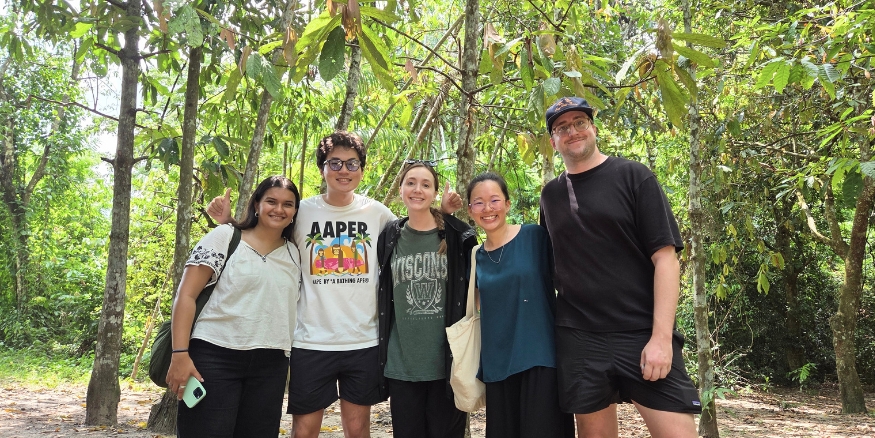
Members of Northwestern University's delegation to the first week of COP30
Thanks for reading.
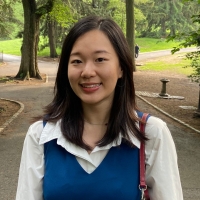 Minjung Kim is a PhD candidate in the Department of Chemistry, a NSF Graduate Research Fellow, and a Paul & Daisy Soros Fellow. Her research utilizes metal-organic frameworks and plasmonic nanoparticles for photocatalysis in sustainability applications. She earned a BS in Chemical Engineering and a BA in Chemistry from Rice University, where she investigated gold nanoclusters and led an award-winning engineering design project to degrade PFAS, or “forever chemicals." Through Northwestern's Science Policy Outreach Taskforce, she authors nonpartisan scientific briefs to inform state-level legislation.
Minjung Kim is a PhD candidate in the Department of Chemistry, a NSF Graduate Research Fellow, and a Paul & Daisy Soros Fellow. Her research utilizes metal-organic frameworks and plasmonic nanoparticles for photocatalysis in sustainability applications. She earned a BS in Chemical Engineering and a BA in Chemistry from Rice University, where she investigated gold nanoclusters and led an award-winning engineering design project to degrade PFAS, or “forever chemicals." Through Northwestern's Science Policy Outreach Taskforce, she authors nonpartisan scientific briefs to inform state-level legislation.

